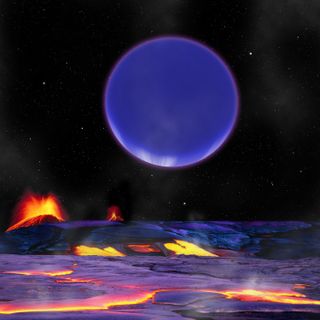Astronomers On the Hunt for Exomoons That May Host Alien Life

The search for alien life doesn't end within the boundaries of our solar system.Scientists are now search for moons orbiting alien planets that might play host to extraterrestrial life.
A new project called the Hunt for Exomoons with Kepler (HEK) is the first systematic search for exomoons, or moons that circle planets outside our solar system.HEK astronomers, led by David Kipping at the Harvard-Smithsonian Center for Astrophysics, simulate billions of possible star-planet-moon arrangements using NASA's Pleiades Supercomputer.
They then compare the results with actual data taken with NASA's Kepler telescope, which monitors the brightness of stars in an effort to find exoplanets that could harbor life. If one of the simulated combinations matches the Kepler data, that area warrants further exploration.
So far, the team has surveyed 56 of about 400 Kepler planet candidates that could have an exomoon. Surveying the remaining 340 would require 50,000 processing hours per object and nearly a decade on a smaller computer.
The Pleiades Supercomputer, which performs over 3 quadrillion calculations per second, knocks that number down to 30,000 processing hours per object and should complete the project in two years.
"For each planet where we don't discover an exomoon, we are able to say how massive a moon is excluded by the current data, telling us about our sensitivity," Kipping said in a statement.

HEK scientists compare the exomoons they're searching for to the moon Pandora in Avatar. But unlike a science-fiction film that depicts complicated and evolved societies, astronomers say signs of life on an exomoon could be as simple as "some form of primitive biology."
Get the Space.com Newsletter
Breaking space news, the latest updates on rocket launches, skywatching events and more!
And life on one moon could mean life on many more.
"If such habitable moons are possible, then there could even be more habitable moons than habitable planets," HEK scientists said on their website.
Although astronomers spotted what might be an exomoon in April 2014, scientists have not confirmed their existence.
Follow us @Spacedotcom, Facebook and Google+. Original article on Space.com.
Join our Space Forums to keep talking space on the latest missions, night sky and more! And if you have a news tip, correction or comment, let us know at: community@space.com.

Kasandra Brabaw is a freelance science writer who covers space, health, and psychology. She's been writing for Space.com since 2014, covering NASA events, sci-fi entertainment, and space news. In addition to Space.com, Kasandra has written for Prevention, Women's Health, SELF, and other health publications. She has also worked with academics to edit books written for popular audiences.